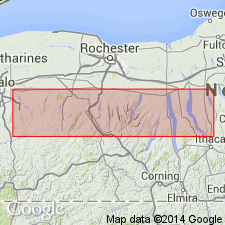
- Usage in publication:
-
- Green's Landing Coral Bed
- Modifications:
-
- Named
- Dominant lithology:
-
- Mudstone
- Limestone
- AAPG geologic province:
-
- Appalachian basin
Summary:
Name Green's Landing Coral Bed is applied to an extremely fossiliferous soft, gray siliciclastic mudstone unit, commonly containing large corals, lying within the Jaycox Member of the Ludlowville Formation. Name was introduced by Mayer (1989) in an unpublished M.S. thesis for exposures on an unnamed creek above Green's Landing at Canandaigua Lake. The Hills Gulch Bed marks the base of the Jaycox and is overlain by an unnamed mudstone, which in turn is overlain by the Green's Landing. Underlies unnamed mudstone interval. Bed is traceable from Buffalo Creek in Erie Co. eastward into the Seneca Lake Valley. Thickness varies from 7 cm at Buffalo Creek, to 54 cm at Murder Creek in Genesee Co., to almost 1 m at the type locality. Contains a diverse array of benthic taxa. Large corals are common to abundant west of Canandaigua Valley, but are replaced by small rugosans in the Seneca Lake Valley. Brachiopods, bryozoans, and crinoids also common. Carbonate content and fossil density decrease eastward. Unit changes from argillaceous limestone in Genesee Co. to silty siliciclastic mudstone at Seneca Lake, where all corals disappear. Age is Middle Devonian.
Source: GNU records (USGS DDS-6; Reston GNULEX).
For more information, please contact Nancy Stamm, Geologic Names Committee Secretary.
Asterisk (*) indicates published by U.S. Geological Survey authors.
"No current usage" (†) implies that a name has been abandoned or has fallen into disuse. Former usage and, if known, replacement name given in parentheses ( ).
Slash (/) indicates name conflicts with nomenclatural guidelines (CSN, 1933; ACSN, 1961, 1970; NACSN, 1983, 2005, 2021). May be explained within brackets ([ ]).

